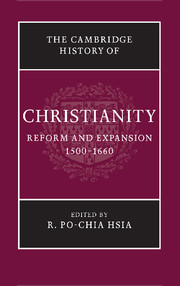Book contents
- Frontmatter
- Part I Luther and the Holy Roman Empire
- Part II The Second Reformation
- Part III Catholic Renewal
- Part IV Resolving Confessional Conflicts
- 13 Peace without concord: religious toleration in theory and practice
- 14 Imposing church and social discipline
- 15 Persecutions and martyrdom
- 16 The Mediterranean Inquisitions of early modern Europe
- 17 Religious colloquies and toleration
- 18 Western Christianity and Eastern Orthodoxy
- Part V Religion, Society, and Culture
- Part VI Christianity and Other Faiths
- Bibliography
- Index
- References
16 - The Mediterranean Inquisitions of early modern Europe
from Part IV - Resolving Confessional Conflicts
Published online by Cambridge University Press: 28 March 2008
- Frontmatter
- Part I Luther and the Holy Roman Empire
- Part II The Second Reformation
- Part III Catholic Renewal
- Part IV Resolving Confessional Conflicts
- 13 Peace without concord: religious toleration in theory and practice
- 14 Imposing church and social discipline
- 15 Persecutions and martyrdom
- 16 The Mediterranean Inquisitions of early modern Europe
- 17 Religious colloquies and toleration
- 18 Western Christianity and Eastern Orthodoxy
- Part V Religion, Society, and Culture
- Part VI Christianity and Other Faiths
- Bibliography
- Index
- References
Summary
There are good reasons to separate the Inquisitors of Heretical Pravity, who had been operating under papal commissions in several parts of Europe since the thirteenth century, from their modern successors. Of course, one must recognize that several fundamental continuities connected medieval inquisitors and modern holy offices. Their purposes were identical: all Inquisitors always sought primarily to uncover and punish heretics. Because both used legal procedures taken from canon law, their modus operandi was essentially identical: no new general handbooks for inquisitors were needed to replace the fourteenth-century models by Bernard Gui or Nicolas Eymeric, which were reprinted centuries later with relatively minor changes for use by their successors. But holy office organization became radically different after 1500 and their activities expanded in new directions, as they began investigating such offences as owning heretical books, homosexuality, or even (for a short time and in a few parts of Spain) horse smuggling.
The early sixteenth century also marks a watershed in inquisitorial history because jurisdiction over heresy, always the principal business of Inquisitions, had passed into the hands of secular courts almost everywhere north of the Alps and Pyrenees around the time of Luther’s Reformation. For anyone accused of heresy, this was an ominous development. In an extreme but significant instance, two successive southern French Inquisitors were themselves indicted as Protestant heretics by the Parlement of Toulouse and the second man was actually burned in 1538. Overall, more than 3,000 Protestants, mostly Anabaptists, were burned for heresy throughout western Europe in the sixteenth century. However, fewer than 10 per cent of them perished at the hands of Inquisitorial courts in Mediterranean Europe.
- Type
- Chapter
- Information
- The Cambridge History of Christianity , pp. 283 - 301Publisher: Cambridge University PressPrint publication year: 2007
References
- 1
- Cited by



